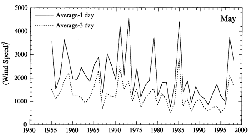
The Bering Sea shelf is a highly variable system at annual and interannual scales. The occurrence and melting of sea ice over the south-eastern shelf usually removes the previous year's heating. The combination of wind mixing and melting ice can cool the water column to about -1.7°C. This was seen in 1995 and 1997 but not in 1998, when weak winds during late winter were insufficient to mix the water column to the bottom at the time the ice was melting. Thus the bottom waters retained both heat and salt from the previous summer. Once mixing occurred after the retreat of the ice, the water column was warmer and saltier than 1995-1997.
The timing and extent of ice is crucial to determine the timing and rapidity of the phytoplankton bloom that occurs over the shelf in the spring. A climate shift that would decrease the extent of ice would have extreme effects not only on the water column structure but also on the phytoplankton blooms and the higher trophic levels that consume them.
Much of the eastern Pacific Ocean exhibited warm sea surface temperature (SST) anomalies during 1997. The SST anomaly extended northward from the Equator, where El Niño conditions existed, into the Arctic Ocean. The warming in the Bering Sea and Arctic Ocean is a consequence of local forcing rather than propagation of warm water from the Equator. In addition, changes in atmospheric forcing influenced the exchange with adjacent oceans (North Pacific and Arctic Oceans) and the circulation on both the Bering Sea basin and shelf. This has important repercussions for the Arctic Ocean. In 1998, warm water was noticed in the Arctic Ocean, which contributed to a reduction in the thickness and extent of the polar ice. The water in the Bering Sea likely enhanced this warming, because of the net northward flow through Bering Strait. Continued warm temperatures in the Bering Sea could have a significant impact on the Arctic ecosystem.
Two of the striking features of atmospheric forcing during 1997 and 1998 were a change in the timing of the last winter storm and weakening of summer (June-July) winds (Fig. 14). The Bering Sea ecosystem is particularly sensitive to storms during May (Sambrotto et al., 1986). The spring bloom strips the nutrients from the upper layer, and the stability of the water column isolates the nutrients in the lower layer. Thus storms in mid-to-late May provide important nutrients for continuation of blooms into summer, and lessen the density difference between the upper and lower layers, thus permitting subsequent minor mixing events to supply nutrients into the photic zone. Storms are less effective at entraining nutrients into the upper layer during June and July, both because they are weaker and because the seasonal strengthening of the thermocline inhibits mixing. From 1986 to 1996 the weather during May was particularly calm; in contrast, May in 1997 and 1998 was characterized by strong individual wind events, which weakened the stability of the water column, creating a pathway for greater nutrient supply, which prolonged primary production. In contrast to stronger winds in May, the summers of 1997 and 1998 had among the weakest mean wind stress since measurements began at St. Paul. This allowed for a shallow mixed layer and thus higher sea surface temperatures. If the pattern of late spring storms and weak summer winds persists, it could change the phytoplankton community. If primary production is prolonged into summer, the total productivity of the shelf could be enhanced, thus affecting higher trophic levels.
Figure 14. Maximum daily wind speed cubed (unbroken line) and 3 day average wind speed cubed (broken line) during May of each year. Winds were measured at St Paul Island.
Whether part of a long-period cycle or a persistent positive trend, the climate of the Arctic (including the Bering Sea) is warming. One example of this is the long-term warming trend in the atmosphere (0.75°C per decade) that occurred from 1961 to 1990 (Chapman and Walsh, 1993). The extent of the permafrost in the land masses surrounding the Bering Sea has decreased (Osterkamp, 1994) and the extent of many Alaskan glaciers has been reduced. A group of scientists convened in 1995 to hypothesize physical changes in the Bering Sea under a global warming scenario (US GLOBEC, 1996). Among the changes they forecast were that wind mixing energy, the supply of nutrients and ice extent/thickness would decrease and sea surface temperature would increase. This combination of conditions was observed during 1997 and may represent a foretaste of what will become typical in the future.
The implication of these changes in the physical environment to changes in biota is difficult to forecast, owing both to the complexity of the interrelationships and to the limited duration and spatial coverage of observations made in the Bering Sea. We need to continue monitoring this system to identify the mechanisms linking short- and long-term physical changes to ecosystem variability. With a better understanding of how the Bering Sea functions, human activities can be managed to minimize their impact on this ecosystem.
We thank Bill Parker, Carol Dewitt, David Kachel and Lynn Long for technical support, Richard Davis for processing of fluorescence data, and George Hunt for enthusiasm and leadership of the Inner Front Program. We express our thanks to the officers and crew of the NOAA Ships Miller Freeman, the R/V Wecoma, R/V Alpha Helix and the CCGS Sir Wilfred Laurier for their field support during the field work. This work was supported by NOAA's Coastal Ocean Program and by OAR, and by the National Science Foundation through the Inner Front Program. This is contribution FOCI-B352 to Fisheries Oceanography Coordinated Investigations, contribution 2040 to PMEL and contribution 657 to JISAO.
Return to previous section or go to the next section